Vatican Museums Complete Guide: Best Tips, Skip-the-Line Tickets & Must-See Highlights
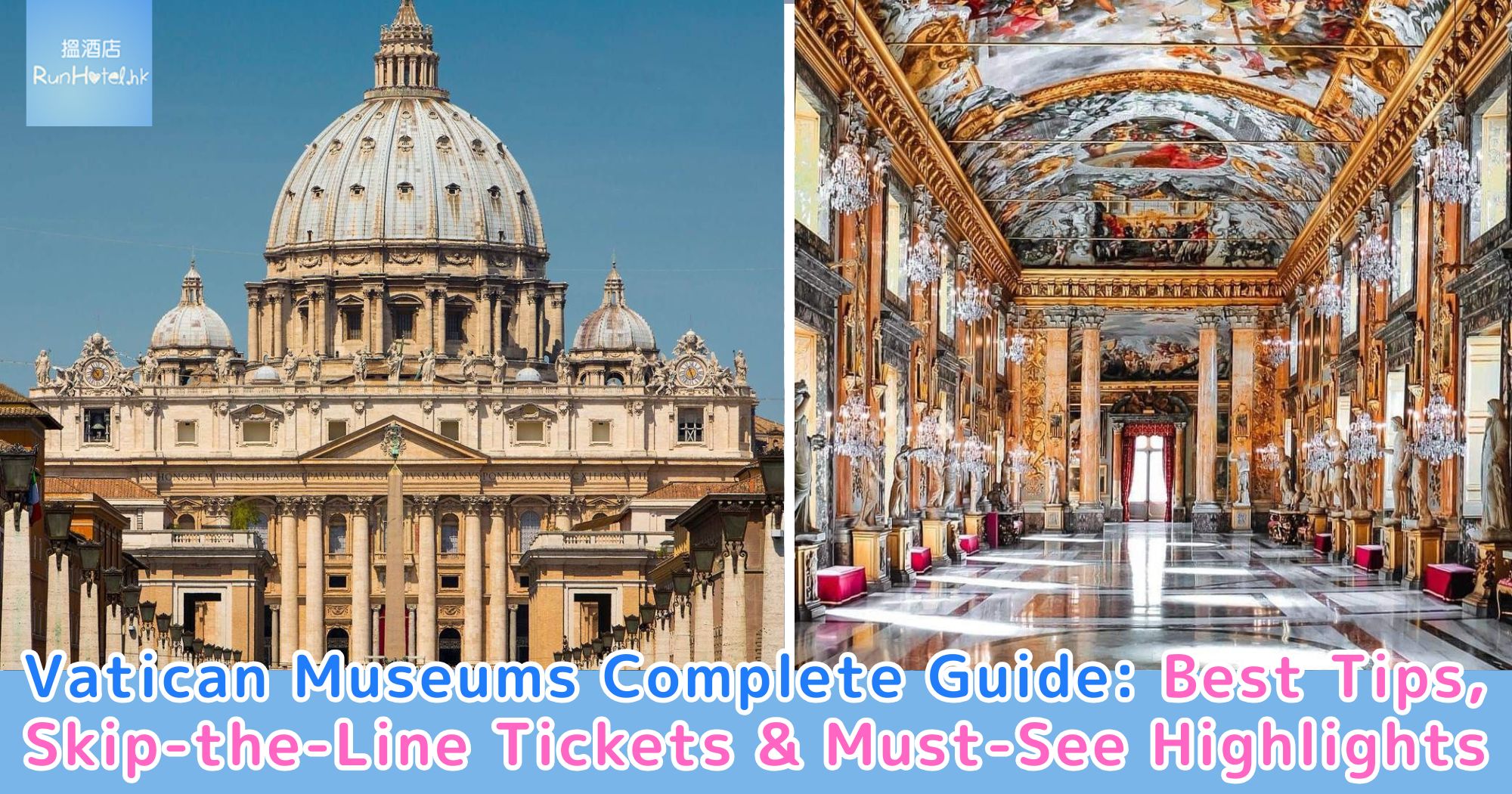

Housed within the world’s smallest sovereign state, the Vatican Museums hold some of humanity’s greatest artistic treasures. From Michelangelo’s breathtaking Sistine Chapel ceiling to Raphael’s philosophical masterpiece The School of Athens, this extraordinary complex attracts over six million visitors annually—and for good reason. Whether you’re an art enthusiast, history buff, or first-time visitor to Rome, the Vatican Museums deliver an unforgettable journey through centuries of human creativity and religious devotion. But here’s the catch: without proper planning, you’ll spend hours in endless queues instead of admiring Renaissance frescoes. This comprehensive guide will show you exactly how to secure tickets, navigate the galleries efficiently, and experience the Vatican’s wonders without the wait.
▼Booking Link▼
Klook: https://www.klook.com/
GetYourGuide : https://www.getyourguide.com/
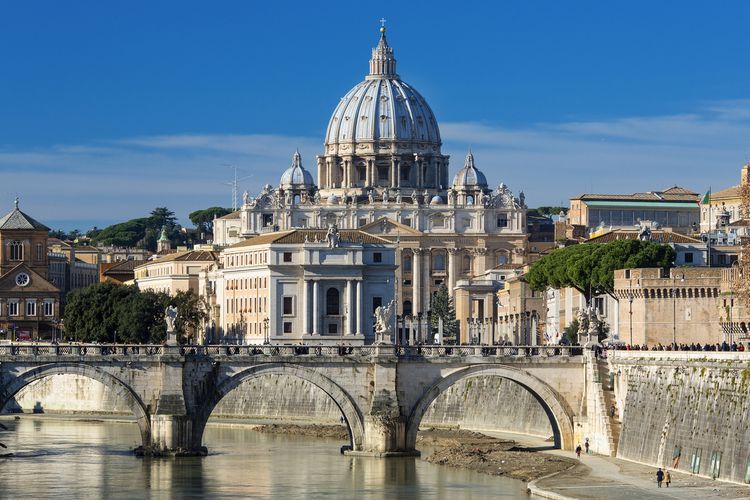
Long queue of tourists waiting outside the Vatican Museums entrance under the iconic colonnade on a sunny day.
Why Visit the Vatican Museums?
The Vatican Museums aren’t just a single museum—they’re a vast network of galleries, halls, and chapels spanning over 7 kilometers of corridors, built up over five centuries since Pope Julius II began the collection in 1506. What makes this destination truly exceptional is the concentration of masterworks by history’s greatest artists all under one roof. You’ll walk through spaces where Michelangelo, Raphael, Leonardo da Vinci, Caravaggio, and countless other masters left their mark.
The museums culminate in the Sistine Chapel, where Michelangelo spent four grueling years on his back painting the iconic ceiling frescoes depicting scenes from Genesis, including the world-famous Creation of Adam. This 930-square-meter masterpiece alone draws visitors from every corner of the globe. But the treasures extend far beyond: you’ll encounter ancient Egyptian artifacts, Greco-Roman sculptures like the emotionally powerful Laocoön and His Sons, the 120-meter Gallery of Maps with its remarkably accurate 16th-century cartography, and Raphael’s philosophical celebration of human knowledge in The School of Athens.

The Creation of Adam fresco on the Sistine Chapel ceiling by Michelangelo in the Vatican Museums.
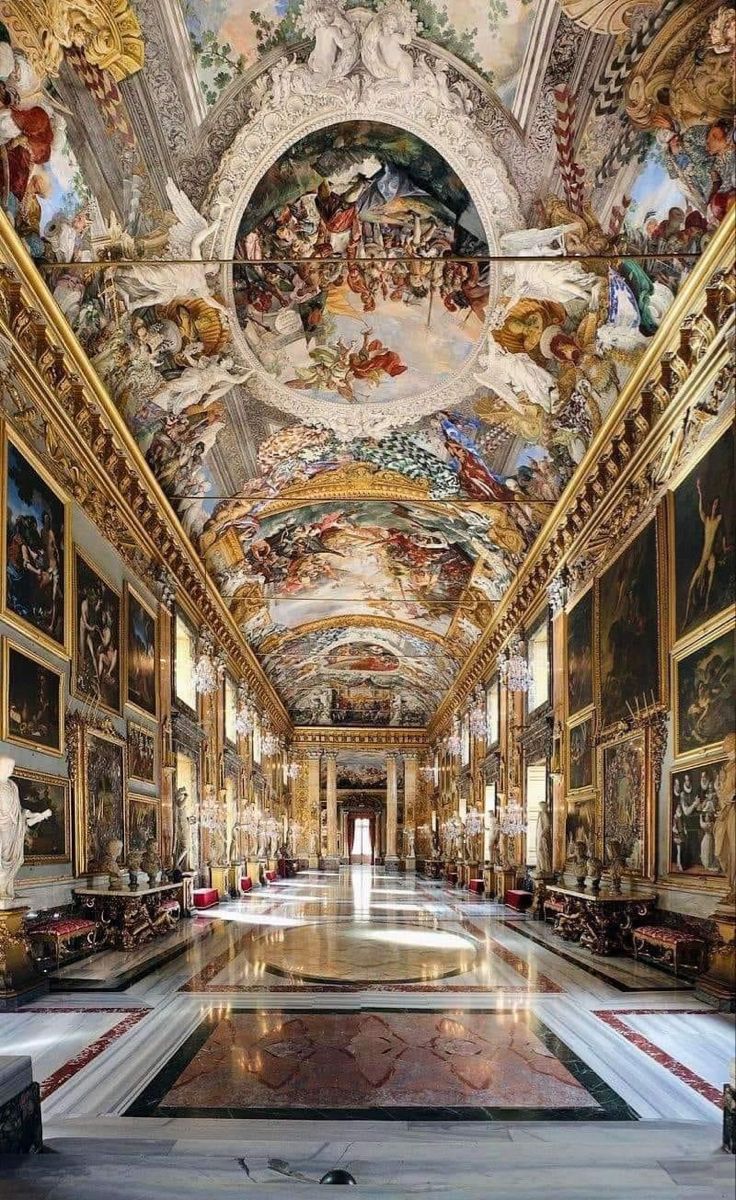
Ceiling frescoes in the Gallery of Maps, Vatican Museums, Rome, showcasing intricate artistic and architectural details.
Beyond the art, the Vatican Museums offer a glimpse into the heart of the Catholic Church and papal history. These were once the private apartments and collections of popes who shaped Western civilization. The architecture itself—from ornate ceilings dripping with gold leaf to the ingenious double-helix spiral staircase—is worthy of admiration. Unlike many museums where you simply view objects behind glass, here you’re immersed in living history, walking the same halls where cardinals have gathered for papal conclaves for centuries.
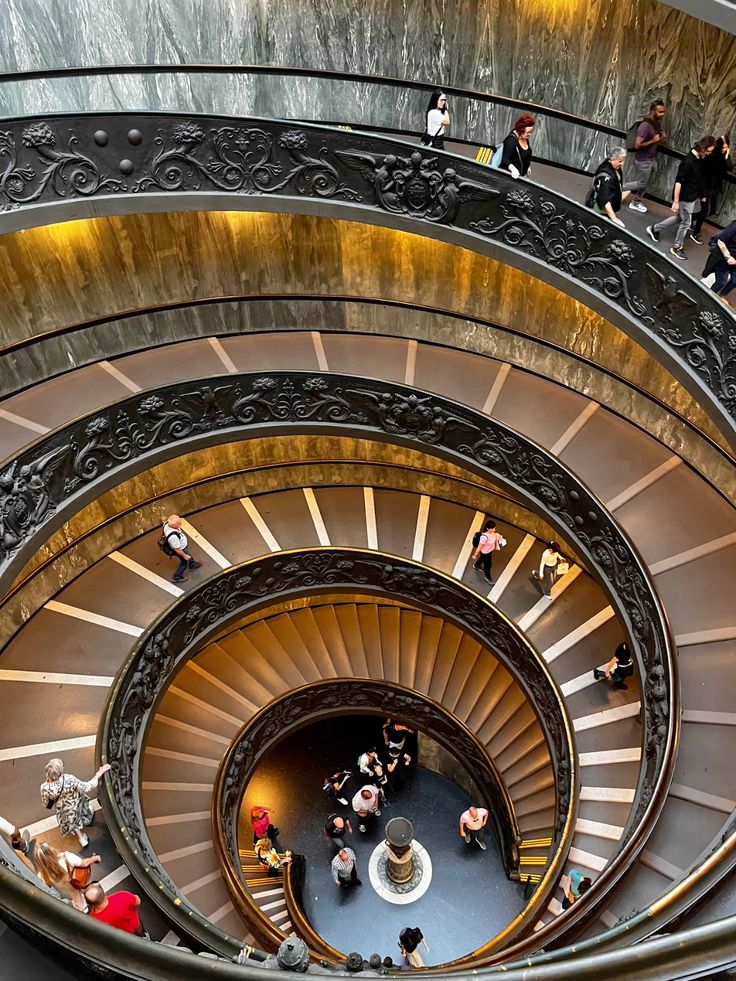
The Bramante Staircase, an iconic double helix spiral staircase inside the Vatican Museums, showcasing intricate Renaissance design and architectural elegance.
Understanding Your Ticket Options: The Key to a Smooth Visit
Navigating Vatican Museums tickets can feel overwhelming, but understanding your options is crucial to avoiding wasted time and frustration. The most important thing to know: tickets sell out days or even weeks in advance, especially during peak season from April through October. Don’t make the mistake of showing up without a reservation.
Official Tickets vs. Skip-the-Line Options
Standard Tickets from the official Vatican Museums website cost €25 for adults and €15 for children aged 6-18 and students under 26 with valid ID. Children under 6 enter free. However, there’s an important catch: these tickets are notoriously difficult to secure. Many travelers report checking the official site only to find dates sold out weeks in advance. The Vatican reserves most tickets for tour groups, leaving limited availability for independent visitors.
This is where third-party platforms become invaluable. GetYourGuide and Klook offer reliable skip-the-line tickets starting around €32-40, which include priority access that saves you 1-3 hours of queue time during peak periods. Yes, it’s slightly more expensive than official tickets, but consider this: during summer, standby ticket queues can stretch for 2-3 hours with no guarantee of entry, as daily visitor quotas are strictly enforced.

The School of Athens fresco by Raphael, a highlight of the Vatican Museums’ Raphael Rooms, showcasing Renaissance art and classical philosophy.
Guided Tours: Worth the Investment?
For first-time visitors, a guided tour (starting around €75-84) offers tremendous value. Expert guides navigate the 8 miles of corridors efficiently, ensuring you don’t miss masterpieces while providing historical context that transforms your experience from sightseeing to genuine understanding. Many tours include the hidden corridor from the Sistine Chapel directly into St. Peter’s Basilica—a route not available with standard tickets—allowing you to skip the basilica’s separate security line.
Pro booking tip: Purchase your tickets at least one week in advance, ideally 2-4 weeks ahead for summer visits. If GetYourGuide shows your preferred date sold out, check Klook—inventory differs between platforms.
Special Entry: Free Last Sunday
Every last Sunday of the month, the Vatican Museums offer free admission from 9:00 AM to 2:00 PM (last entry 12:30 PM). While this sounds appealing for budget travelers, be warned: crowds are absolutely massive, and you’ll still face long security lines. Only consider this option if you’re prepared for shoulder-to-shoulder viewing conditions and have flexibility in your schedule.
Opening Hours and Best Times to Visit
The Vatican Museums operate Monday through Saturday from 8:00 AM to 8:00 PM, with last entry at 6:00 PM. The galleries begin clearing 30 minutes before closing at 7:30 PM. The museums are closed on Sundays (except the free last Sunday) and on major Catholic holidays including January 1, February 11, March 19, May 1, June 29, August 15, November 1, and December 25-26.
The Golden Hour: Early Morning Entry
Ask any Vatican veteran and they’ll give you the same advice: arrive right at 8:00 AM opening. This is hands-down the best time to visit. Early risers enjoy nearly empty galleries for the first 1-2 hours before the flood of tour groups arrives around 10:00 AM. The difference is dramatic—you can actually breathe in the Gallery of Maps and find a quiet spot to contemplate the Sistine Chapel ceiling without hundreds of others jostling for space.

The Gallery of Maps displays stunning frescoed ceilings and detailed historical maps at the Vatican Museums.
If you can’t manage the crack-of-dawn entry, the next best window is around 1:00-2:00 PM when morning visitors begin leaving for lunch. Avoid the 10:00 AM to 12:00 PM peak at all costs—this is when the museums are at maximum capacity and viewing conditions are at their worst.
For an extraordinary experience, some tour operators offer exclusive after-hours or early-access tickets (starting around €119) that grant entry before or after public hours. While pricey, these provide the rare privilege of seeing Michelangelo’s masterpieces in near-silence, which many consider priceless.
Best Days and Seasons
Tuesdays, Thursdays, and Fridays typically see lighter crowds than Mondays, Wednesdays, and Saturdays. Avoid visiting during the week of April 25-May 1 (Italian national holidays) and the Christmas period when crowds swell.
Summer (June-August) brings peak tourist season with maximum crowds and heat, though extended daylight hours make the experience pleasant. For the best balance of weather and manageable crowds, visit during shoulder seasons: October-November or February-April. Winter months offer the smallest crowds and sometimes discounted tickets, though shorter daylight hours and occasional rain are trade-offs.
What to Bring and Dress Code Requirements
The Vatican enforces a strict dress code that’s non-negotiable—violate it and you’ll be turned away at the entrance, even with a valid ticket. This applies to the museums, Sistine Chapel, and all sacred spaces within Vatican City.
Dress Code Essentials
Shoulders must be covered for everyone. Sleeveless tops, tank tops, spaghetti straps, and halter tops are prohibited. Knees must be covered, meaning shorts, miniskirts, and dresses must extend at least to the knee. Guards are vigilant and will measure if there’s any question.
Additional restrictions include: no hats or caps inside buildings (religious exceptions permitted), no ripped or sheer clothing, no flip-flops (sandals with back straps are acceptable), no clothing with offensive slogans or imagery, and no overly revealing or form-fitting athletic wear.
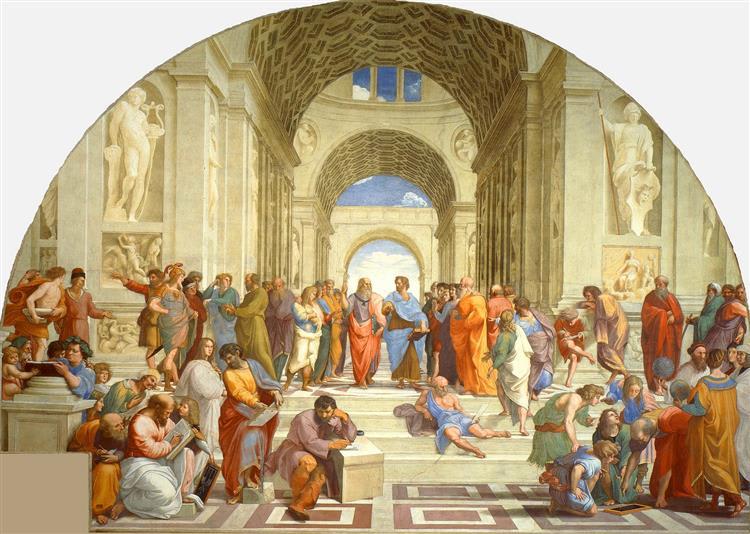
The School of Athens fresco by Raphael, located in the Vatican Museums’ Raphael Rooms, showcasing ancient philosophers in a grand architectural setting.
Recommended outfits: Women should opt for midi dresses or skirts with a light cardigan or shawl, linen trousers with a sleeved blouse, or capri pants with a T-shirt that covers shoulders. Men can wear lightweight trousers or knee-length shorts with a polo shirt or button-down. Bring a lightweight scarf or wrap that can quickly cover bare shoulders if needed.
Practical Items to Pack
Bring comfortable walking shoes—you’ll cover several kilometers on marble and stone floors. A small backpack is permitted (large luggage must be checked). Water and snacks are allowed and recommended, though you can also purchase refreshments at the on-site cafeteria. Earphones with a round jack are essential if you rent the audio guide, as the museums don’t provide them. Finally, bring a portable phone charger—you’ll be snapping photos throughout the visit.
Photography is permitted in most areas except the Sistine Chapel, where both photography and talking are strictly forbidden.
Must-See Highlights: Your Essential Route
With 7 kilometers of corridors and countless galleries, strategic planning is essential. Most visitors spend 3-4 hours in the museums; art enthusiasts can easily fill 5-6 hours. Here’s an efficient route hitting the absolute must-sees.
Pio-Clementino Museum: Ancient Masterpieces
After entering and passing through security, you’ll reach the ancient sculpture galleries. Make your way to the Octagonal Courtyard where you’ll encounter Laocoön and His Sons, a first-century BC marble sculpture depicting the Trojan priest and his sons being attacked by sea serpents. This emotionally intense work so captivated Michelangelo that it influenced his own figures in the Sistine Chapel.
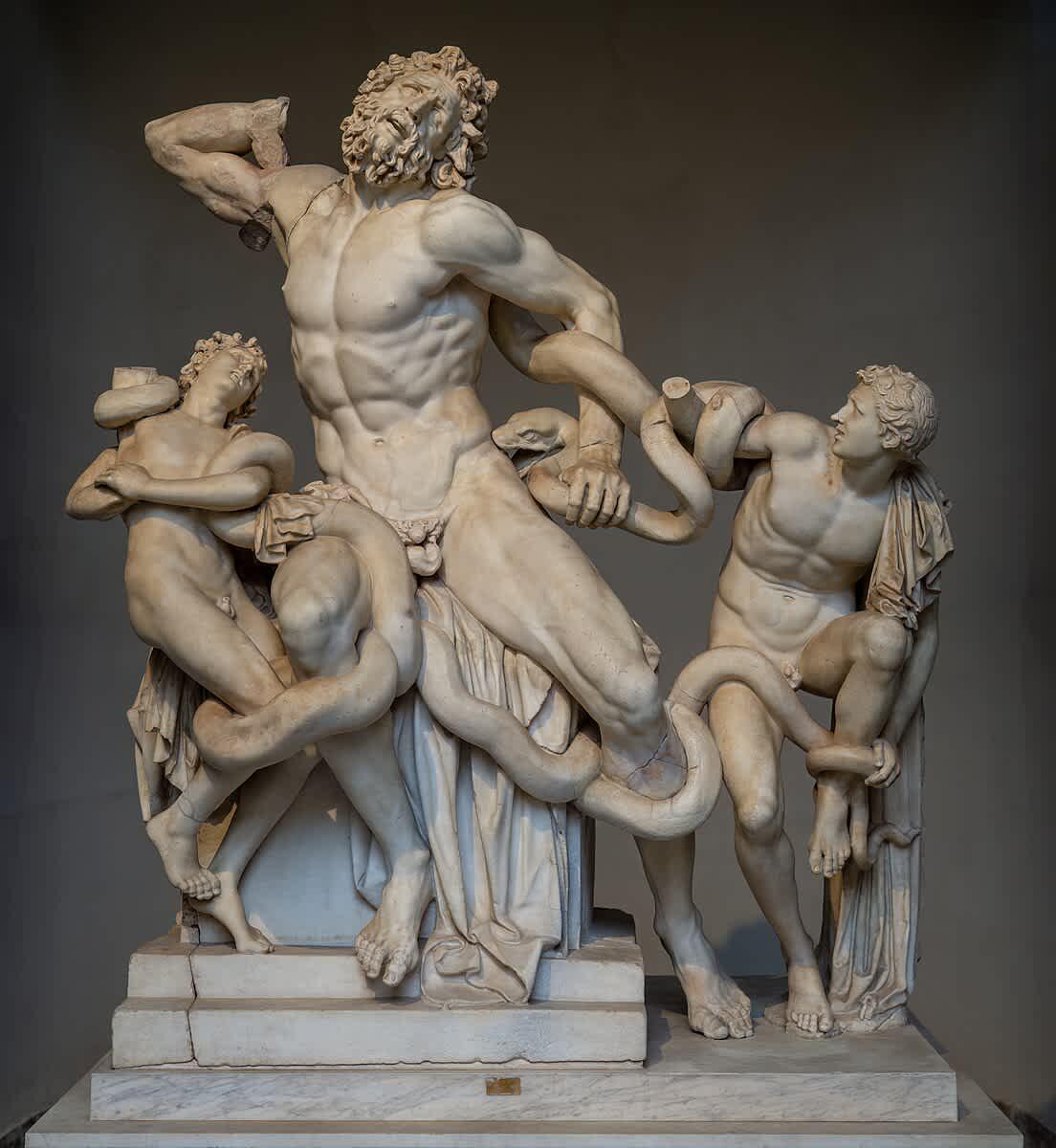
Laocoön and His Sons: a striking ancient sculpture housed in the Vatican Museums, exemplifying Hellenistic artistry and mythological storytelling.
Nearby, don’t miss the Apollo Belvedere, considered the “standard of beauty” during the Renaissance, and the Belvedere Torso, a fragmentary sculpture that Michelangelo refused to restore, insisting its powerful musculature was perfect as-is. In the Round Room, you’ll find Emperor Nero’s massive red porphyry bathtub and a golden statue of Hercules.
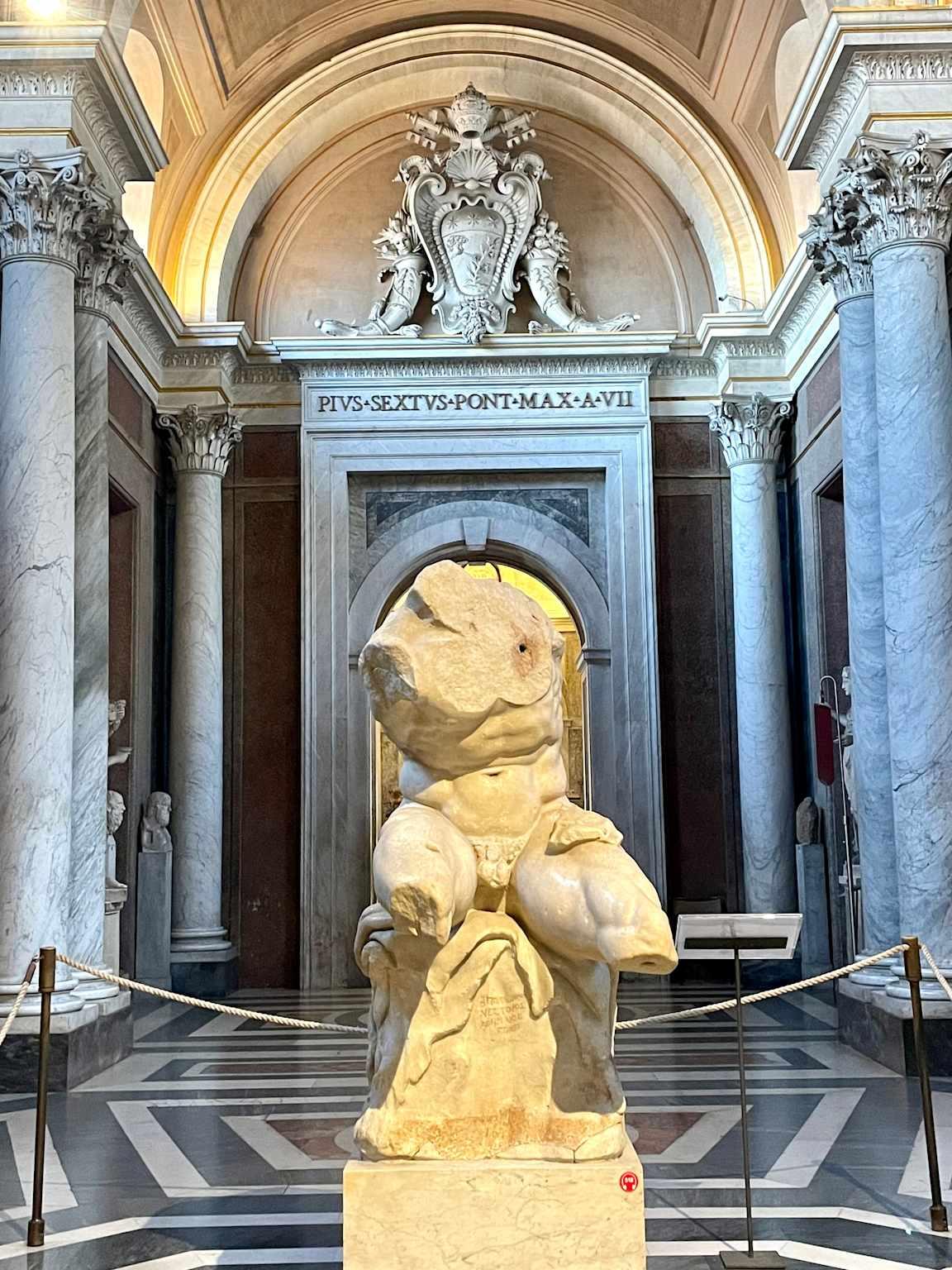
The Belvedere Torso, a renowned ancient marble sculpture, prominently displayed inside the Vatican Museums.
Gallery of the Candelabra and Gallery of Tapestries
These connecting galleries feature impressive Roman sculptures and massive marble candelabra, plus intricate 16th-century tapestries depicting biblical scenes. The craftsmanship is so detailed they resemble paintings. While beautiful, move through at a steady pace—the real treasures lie ahead.
Gallery of Maps: Golden Splendor
This 120-meter corridor is pure visual overload in the best way possible. The walls display 40 hand-painted maps of Italy’s regions commissioned in the 1580s, offering fascinating glimpses into Renaissance cartography. But look up—the gilded ceiling frescoes depicting religious events corresponding to each mapped region are absolutely stunning. This is Instagram gold, but it’s also perpetually crowded, so snap your photos quickly and keep moving.
Raphael Rooms: Renaissance Philosophy and Drama
The Raphael Rooms (Stanze di Raffaello) represent the creative pinnacle of High Renaissance art. Pope Julius II commissioned Raphael and his workshop to fresco four interconnected chambers that served as papal apartments.
The Room of the Segnatura contains The School of Athens, arguably Raphael’s masterpiece. This fresco depicts over 50 ancient philosophers, mathematicians, and scientists gathered in an idealized classical setting. At the center, Plato (modeled after Leonardo da Vinci) points upward to the realm of ideas while Aristotle gestures toward earthly reality. Raphael painted himself into the scene—he’s the young man in the black beret on the right side—and immortalized his rival Michelangelo as the brooding figure seated on the steps.
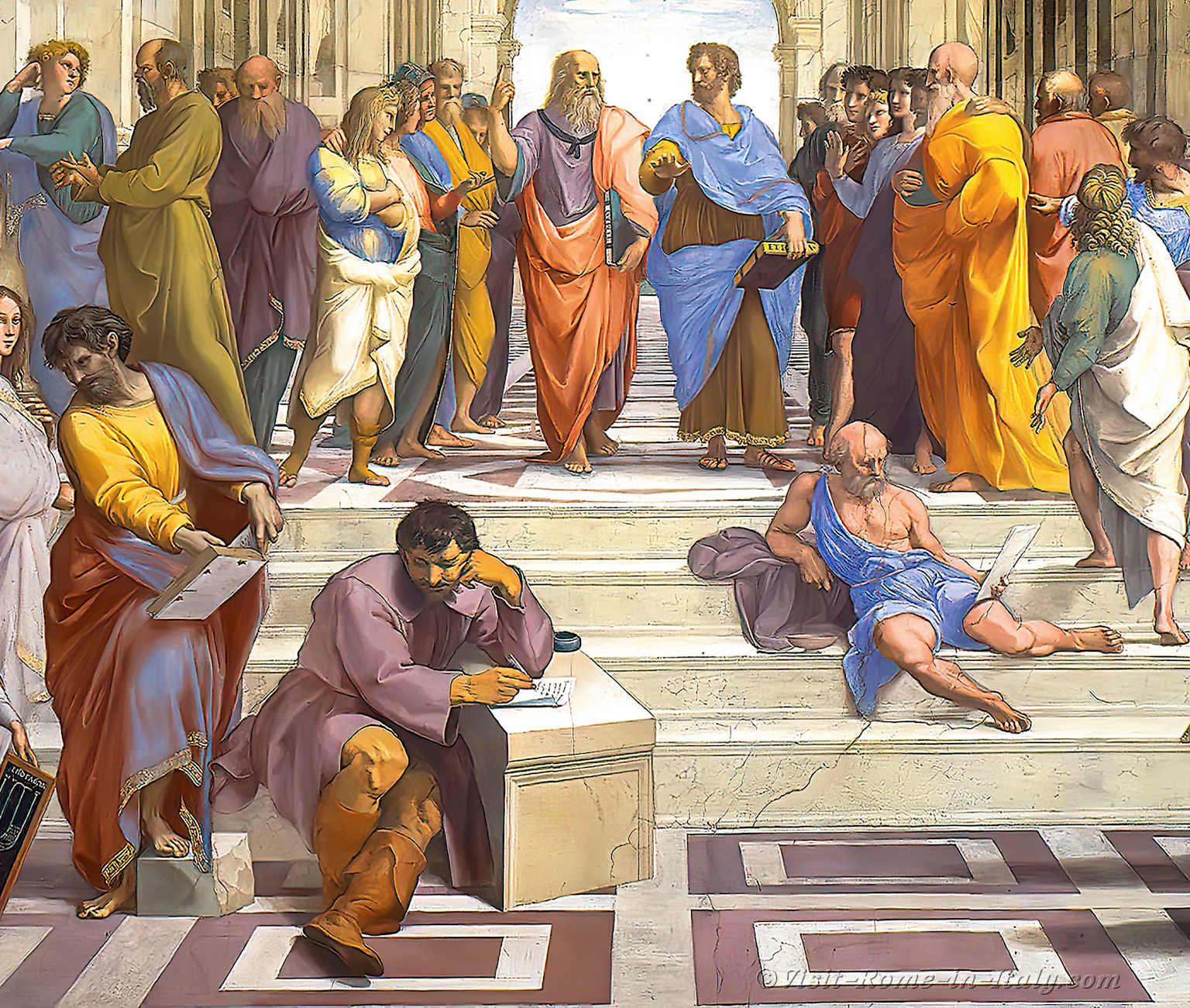
The School of Athens fresco by Raphael, a highlight of the Vatican Museums’ Raphael Rooms, showcasing Renaissance art and classical philosophy.

The School of Athens fresco by Raphael, a masterpiece in the Vatican Museums’ Raphael Rooms showcasing classical philosophers.

Raphael’s School of Athens fresco in the Vatican Museums, showcasing classical philosophy and Renaissance artistry.
The same room features Disputation of the Holy Sacrament, depicting theological debate across three tiers representing heaven, purgatory, and earth. In the Room of Heliodorus, Raphael’s Liberation of St. Peter demonstrates his mastery of light, showing an angel freeing the apostle from prison in a scene of divine illumination.
The Sistine Chapel: Michelangelo’s Triumph
Everything builds to this moment. After navigating the galleries, you’ll enter the Sistine Chapel—and the impact is immediate and overwhelming. Completed between 1508-1512, Michelangelo’s ceiling frescoes depict nine scenes from Genesis, surrounded by prophets, sibyls, and the ancestors of Christ.
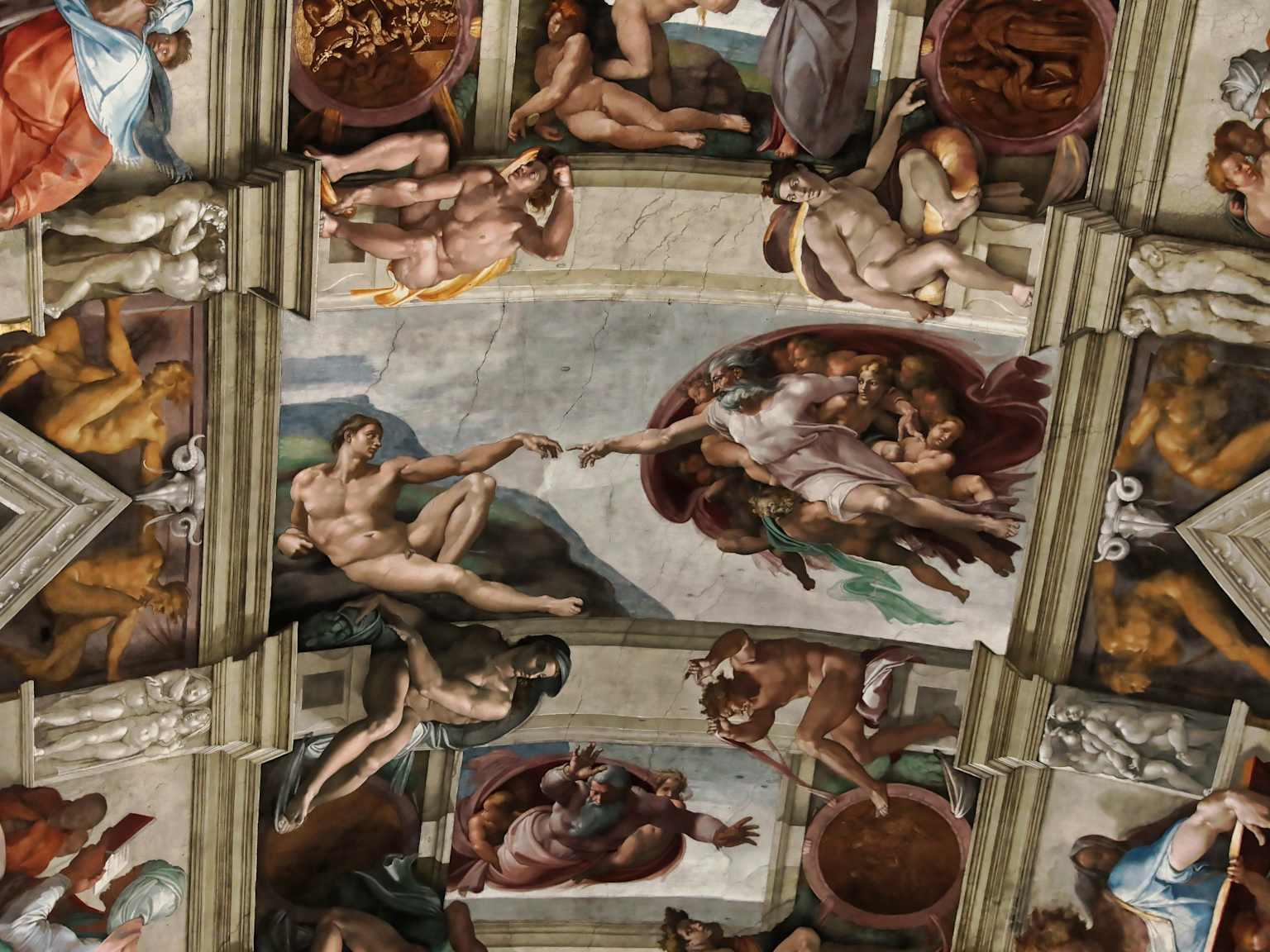
The Creation of Adam fresco on the Sistine Chapel ceiling by Michelangelo in the Vatican Museums.

Michelangelo’s The Last Judgment, the iconic fresco on the Sistine Chapel altar wall, a highlight in the Vatican Museums.
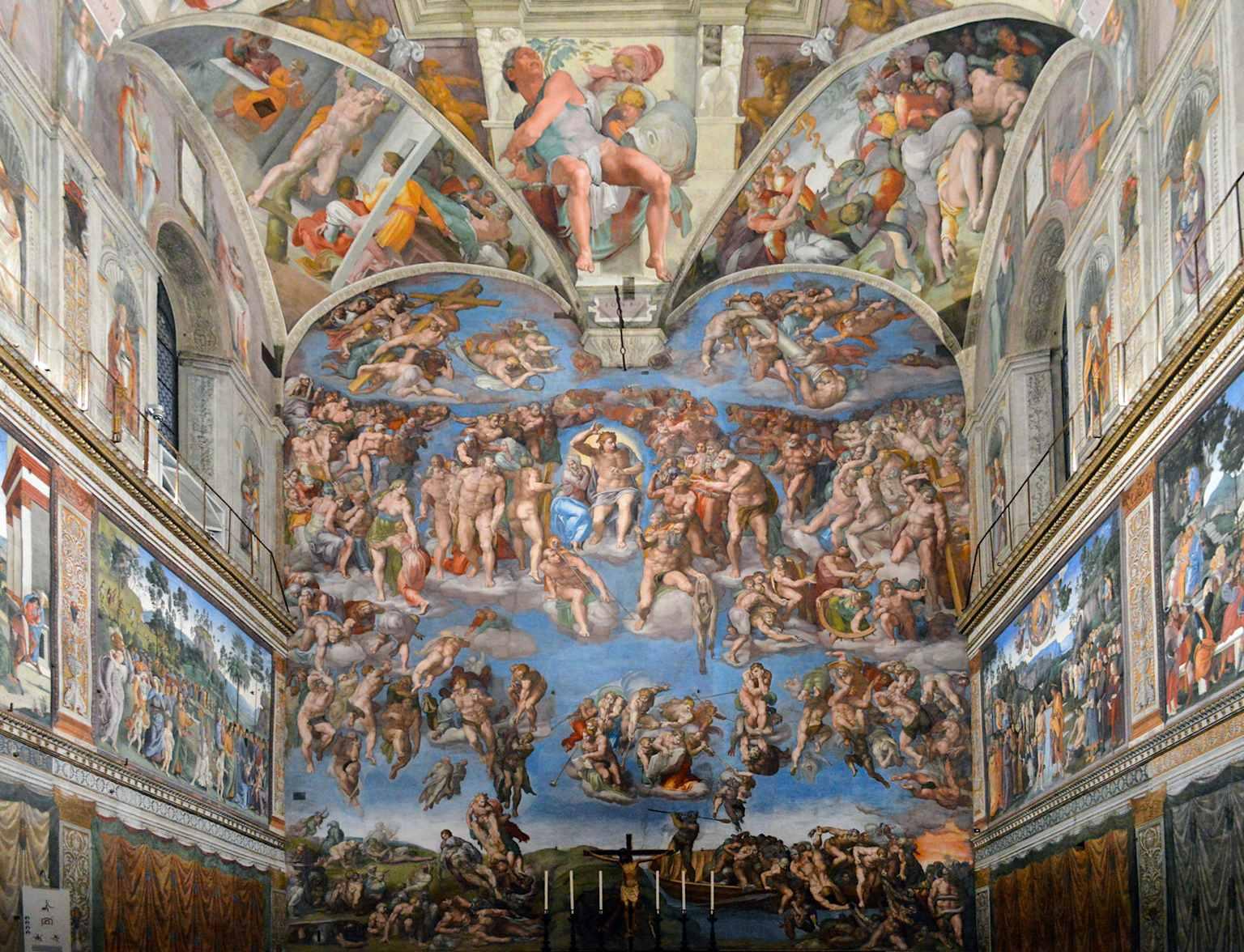
Michelangelo’s Last Judgment fresco in the Sistine Chapel, Vatican Museums’ iconic masterpiece.
The center panel showing The Creation of Adam—God’s finger nearly touching Adam’s as life is transferred—has become one of the most reproduced images in human history. But don’t miss the surrounding panels: The Creation of Eve, The Fall and Expulsion from Paradise, The Deluge, and others showcase Michelangelo’s unparalleled understanding of human anatomy and his revolutionary use of color and perspective.
Twenty-nine years later, Michelangelo returned to paint The Last Judgment on the altar wall, depicting Christ’s second coming and the final judgment of souls with terrifying detail. The composition shows the saved ascending to heaven on the left while the damned are dragged to hell on the right—Dante’s Inferno rendered in fresco.
Michelangelo’s Last Judgment in the Sistine Chapel, Vatican Museums
Important: Photography and talking are absolutely forbidden in the Sistine Chapel. Guards enforce this strictly and will escort out violators. Many tour guides explain the artwork before entering so you understand what you’re seeing, which significantly enriches the experience.
The Double Helix Staircase: Don’t Skip the Exit
As you exit, you’ll encounter Giuseppe Momo’s spectacular double-helix spiral staircase from 1932. This architectural marvel features two intertwined staircases that never meet, decorated with papal coats of arms. It’s one of the most photographed spots in the Vatican, so take a moment to capture this final wonder.

The Bramante Staircase, an iconic double helix spiral staircase inside the Vatican Museums, showcasing intricate Renaissance design and architectural elegance.
The Pinacoteca: Hidden Gem for Art Lovers
If you have energy remaining, the Pinacoteca (Vatican Picture Gallery) rewards the effort with 18 chronologically arranged rooms containing paintings from the Middle Ages through the 1800s. Highlights include Caravaggio’s dramatic Entombment of Christ with its revolutionary chiaroscuro technique, Raphael’s Transfiguration (his final work), and the only Leonardo da Vinci in the Vatican—a sketch called St. Jerome in the Wilderness. Most visitors skip this section due to fatigue, making it pleasantly uncrowded.
Visiting Tips and Common Mistakes to Avoid
Don’t try to see everything. With 54 galleries and museums, attempting comprehensive coverage is a recipe for exhaustion and diminishing returns. Focus on the highlights outlined above, which deliver the most impactful experience in 3-4 hours.
Add the audio guide. When booking tickets on GetYourGuide or Klook, the option to add an audio guide for €7-8 is worthwhile. The commentary brings context to otherwise mysterious artworks. Remember to bring round-jack earphones since they’re not provided.
Beware of ticket scammers. Near the entrance, you’ll encounter people selling tickets at inflated prices, sometimes fake. Only purchase from official channels or reputable platforms like GetYourGuide and Klook.
The museums are one-way. The route is designed for one-directional flow, and backtracking against the crowd is nearly impossible. If you miss something, you’re better off continuing forward and catching it on a future visit.
Visit restrooms strategically. Facilities are located in the basement level near the entrance, in the Pine Cone Courtyard, and near the exit. Lines can be long, so plan accordingly.
Combine wisely with St. Peter’s Basilica. While both are in Vatican City, they require separate visits with separate security checks. If you’re doing both in one day, most experts recommend visiting the basilica first (arriving at 7:00 AM when it opens) since it’s free and doesn’t require timed entry, then heading to your reserved Vatican Museums slot. Alternatively, book a guided tour that includes the shortcut from the Sistine Chapel directly into the basilica.
Getting There: Transportation and Logistics
The Vatican Museums entrance is located at Viale Vaticano 100, on the north side of Vatican City. The most convenient access is via Metro Line A (red line) to either Cipro-Musei Vaticani station (5-minute walk) or Ottaviano-San Pietro station (10-minute walk). Both stations are clearly marked and easy to navigate.
From Termini Station, take Metro Line A toward Battistini and get off at either stop (approximately 10-15 minutes). Taxis are another option, though Rome’s traffic can be unpredictable. Walking from central Rome landmarks like Piazza Navona takes about 25-30 minutes along pleasant streets.
When you arrive, follow signs to the entrance. Even with skip-the-line tickets, you must pass through mandatory security screening (metal detectors and bag checks), which can take 10-30 minutes depending on the tim. Arrive 15-20 minutes before your reserved time slot to account for security.
Frequently Asked Questions
How long should I budget for my visit?
Most visitors spend 3-4 hours, which is sufficient to see the major highlights at a comfortable pace. Dedicated art enthusiasts should budget 5-6 hours to include the Pinacoteca and other specialized galleries.
Can I bring a backpack and luggage?
Small backpacks and purses are permitted, but large suitcases and oversized bags must be checked at the luggage storage on the ground floor. Storage is free, but lines can be long, so pack light if possible.
Is the Vatican Museums ticket the same as the Sistine Chapel?
Yes—your Vatican Museums ticket includes access to the Sistine Chapel, which is located within the museum complex. You cannot visit the Sistine Chapel separately; it’s part of the museums route.
Do I need separate tickets for St. Peter’s Basilica?
St. Peter’s Basilica is free to enter and does not require a ticket. However, you must queue separately through security (often 1-2 hours during peak times). The basilica is technically separate from the museums, though some guided tours include passage between them via a special corridor.
Can I buy tickets at the door?
Yes, but this is strongly discouraged. Standby queues regularly reach 2-3 hours, and there’s no guarantee of entry if daily capacity is reached. Booking at least a week ahead via GetYourGuide or Klook is essential.
Are children welcome?
Absolutely. Children under 6 enter free, and ages 6-18 receive reduced pricing. The museums provide strollers, though navigating crowds can be challenging. Be aware that the dress code applies to children as well—shoulders and knees must be covered.
Is there food available?
There’s a self-service cafeteria in the Pine Cone Courtyard offering sandwiches, salads, coffee, and snacks at moderately inflated prices. You’re also permitted to bring your own food and water, which is recommended for budget-conscious travelers.
Can I re-enter after exiting?
No. All Vatican Museums tickets are single-entry only. Once you exit, you cannot return without purchasing a new ticket.
Final Thoughts: Making the Most of Your Vatican Experience
The Vatican Museums represent one of humanity’s supreme cultural achievements—a place where art, history, religion, and architecture converge in spectacular fashion. While the crowds and logistics can feel daunting, proper preparation transforms the experience from stressful to sublime. Book your skip-the-line tickets early through GetYourGuide or Klook, arrive at opening time if possible, dress appropriately, wear comfortable shoes, and pace yourself through the galleries.
Most importantly, when you stand beneath Michelangelo’s Sistine Chapel ceiling or gaze at Raphael’s philosophers debating in an imagined Athens, take a moment to truly absorb what you’re witnessing. These aren’t just old paintings—they’re humanity’s boldest attempts to capture divinity, knowledge, beauty, and truth in visual form. The Vatican Museums offer a rare opportunity to commune with genius across the centuries, and with the right preparation, that encounter will stay with you long after you’ve left Rome.
▼Booking Link▼
Klook: https://www.klook.com/
GetYourGuide : https://www.getyourguide.com/







